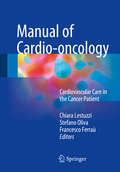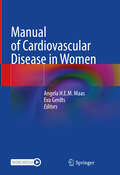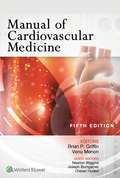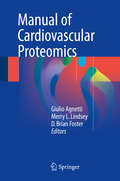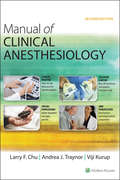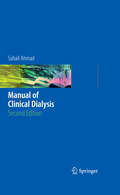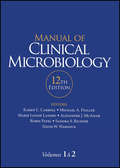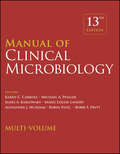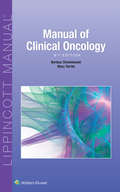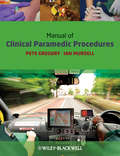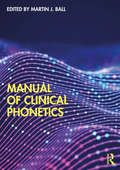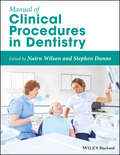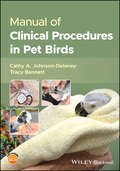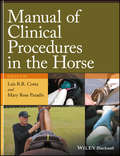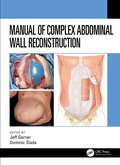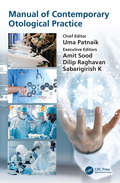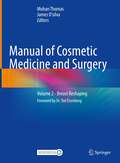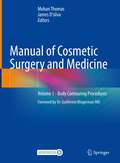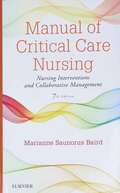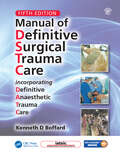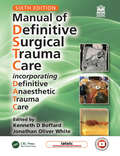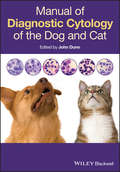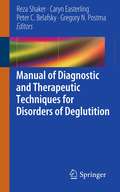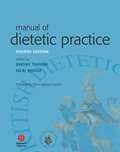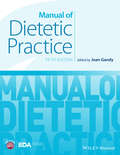- Table View
- List View
Manual of Cardio-oncology
by Chiara Lestuzzi Stefano Oliva Francesco FerraùThis concise and handy manual provides straightforward, up-to-date guidance for cardiologists and other practitioners on the management of cancer patients with cardiac problems, whether they be due to the cancer itself or to antineoplastic treatment. Detailed attention is devoted to the various forms of cardiotoxicity associated with chemotherapy and radiotherapy. The drugs commonly responsible for each toxicity are identified and clear advice is offered on monitoring techniques and treatment approaches. In addition, the issue of cardiotoxicity due to cancer treatment in particular patient groups - children, the elderly, and those with pre-existing cardiac disease - is addressed separately, with guidance on when and how antineoplastic (and/or cardiological) treatments should be modified. Further sections describe the correct responses to cardiac problems secondary to the cancer itself, including thromboembolic disorders and electrolyte imbalances, and the diagnosis, treatment, and follow-up of cardiac tumors. A closing section considers how to improve cooperation between oncologists, cardiologists, and general practitioners to ensure that cancer patients' cardiovascular needs are met in a multidisciplinary approach.
Manual of Cardiovascular Disease in Women
by Angela H. E. M. Maas Eva GerdtsThis manual defines sex and gender differences in cardiovascular disease and how they have become an important topic within most subspecialities in the field of cardiology. It is now evident that sex differences in biology and lifestyle influence the pathophysiology of heart disease. Consequently risk factors for cardiac disease are modified by sex and gender, and women and men develop partly different variants of the same heart diseases. These facts profoundly influence prevention and management in clinical practice. Good medical practice demands a more tailored and personal care for each individual patient. In addition, the life-course of women has a few unique phases, related to hormonal changes in pregnancy and after menopause, that also interact with individual risk and the development of co-morbidities. As heart disease is now the number one cause of death in women worldwide, a more specific attention to cardiovascular disease in women is justified. Most important advances in gender-specific knowledge are related to ischemic heart disease and its traditional and sex-specific risk factors. Diagnostic pathways have changed, coronary angiography is no longer the gold standard that it used to be. Recent guidelines and position papers have paid attention to these new insights, whereas educational programs urgently need to be adapted. The ongoing paradigm shift in cardiology needs to be updated for the clinician in an easy and accessible manner. Other important topics in which sex and gender differences have been elaborated are heart failure, atrial fibrillation, aortic valve disease and its treatment, cardiac rehabilitation, co-morbidities, cardiotoxicity in cancer treatment and neurology. In addition, female-specific risk factors and socio-economic factors are relevant to women’s cardiovascular health. We will invite the best EU experts in this field to contribute to the various chapters. Manual of Cardiovascular Disease in Women has an educational role for established cardiologists and vascular specialists in training, nurses and other allied professionals. It represents an update on the most recent insights in sex- and gender differences in cardiovascular health with a focus on women’s cardiovascular diseases. Additional questions via app: Download the Springer Nature Flashcards app for free and use exclusive additional material to test your knowledge.
Manual of Cardiovascular Medicine
by Brian P. GriffinPublisher's Note: Products purchased from 3rd Party sellers are not guaranteed by the Publisher for quality, authenticity, or access to any online entitlements included with the product. An ideal reference for residents, fellows, practitioners, and nurse practitioners, Manual of Cardiovascular Medicine, 5th Edition is a concise, up-to-date overview of key topics in cardiology. Using a practical, outline format, this best-selling title presents evidence-based approaches to cardiovascular diagnosis, diseases, and treatment – perfect for daily practice or exam preparation.
Manual of Cardiovascular Proteomics
by Giulio Agnetti Merry L. Lindsey D. Brian FosterThis book fulfils the need to keep up with the high number of innovations in proteomics, and at the same time to warn the readers about the danger of manufacturers and scientists claims around new technologies. Mass spectrometry stands as the core technology in proteomics. The emerging field of targeted proteomics and its potential applications in the cardiovascular arena are also reviewed and discussed. A concluding section highilghts the promise of proteomics in the light of these recent developments. As this technique and its applications have undergone remarkable advances in the past years, recent updates on proteomic applications are covered. Another key concept revealed by proteomic technologies is that the extent of protein post-translational modifications (PTMs) as well as their impact on the phenotype has been underestimated by pre-proteomics science. As such, part of the manual focuses on the emerging role of PTMs in basic cardiovascular sciences and in the clinics. In fact, there is an emerging consensus that the detailed annotation of protein PTMs could lead to a more in-depth representation of biological systems, translating into more specific targets for therapy as well as biomarkers. Moreover, a recent trend is so-called "targeted proteomics". The approach was awarded the title of "Method of the Year" by Nature in 2013 (see the editorial by Vivien Marx in 1st issue of Nature in Jan 2013). According to a few proteomic scientists the emphasis should not be placed on generating long lists of proteins but lists of proteins with a true biological meaning.
Manual of Clinical Anesthesiology
by Larry F. Chu Andrea J. Traynor Viji KurupDesigned for rapid reference at the point of care, Manual of Clinical Anesthesiology is the clinician’s go-to resource for practical, clinically focused information on all aspects of anesthesia management. The comprehensive second edition consolidates multidisciplinary expertise in one resource, offering revised and updated content in a highly visual, portable format, with short, easy-to-read chapters, margin icons noting pearls and pitfalls, and more.
Manual of Clinical Dialysis
by Suhail AhmadThis second edition of the Manual of Clinical Dialysis is a concise and well-illustrated guide to all aspects of dialysis. All chapters have been revised and present a complete overview of the techniques, processes and equipment involved in clinical dialysis as well as an overview of the complications of dialysis. The manual also provides an overview of common clinical problems related to renal failure such as hypertension, anemia and renal osteodystrophy.
Manual of Clinical Microbiology 2 Volume Set (ASM Books)
by Michael A. Pfaller James H. JorgensenRevised by a collaborative, international, interdisciplinary team of editors and authors, this edition includes the latest applications of genomics and proteomics and is filled with current findings regarding infectious agents, leading-edge diagnostic methods, laboratory practices, and safety guidelines. This edition also features three new chapters on accreditation, Mycobacterium tuberculosis complex, and human herpesvirus 8. This seminal reference of microbiology continues to set the standard for state-of-the-science laboratory practice as the most authoritative reference in the field of microbiology.
Manual of Clinical Microbiology, 4 Volume Set (ASM Books)
by Michael A. Pfaller Karen C. Carroll Marie Louise Landry Alexander J. McAdam Robin Patel James A. Karlowsky Bobbi S. PrittRevised by a collaborative, international, interdisciplinary team of editors and authors, this edition of the Manual of Clinical Microbiology includes the latest applications of genomics and proteomics and is filled with current findings regarding infectious agents, leading-edge diagnostic methods, laboratory practices, and safety guidelines. This edition also features four new chapters: Diagnostic Stewardship in Clinical Microbiology; Salmonella; Escherichia and Shigella; and Morganellaceae, Erwiniaceae, Hafniaceae, and Selected Enterobacterales. This seminal reference of microbiology continues to set the standard for state-of-the-science laboratory practice as the most authoritative reference in the field of microbiology. If you are looking for online access to the latest from this reference or site access for your lab, please visit www.wiley.com/learn/clinmicronow.
Manual of Clinical Oncology (Spiral Manuals)
by Bartosz Chmielowski Mary TerritoConcise, portable, and packed with essential information, Manual of Clinical Oncology is an indispensable resource for understanding basic science, clinical findings, and available technology as they relate to the diagnosis and management patients with cancer. The practical format provides high-yield content useful for participating in rounds ad making diagnostic and therapeutic decisions at the bedside. Edited by Dr. Bartosz Chmielowski and Dr. Mary Territo, both from UCLA School of Medicine, this eighth edition carries on the tradition of excellence set forth by longtime editor Dr. Dennis Casciato. Incorporates recent major achievements in immunotherapies, biologics, and targeted therapies. Features new chapters on the biology of cancer, immunotherapy, and cancer survivorship. Contains numerous diagnostic and treatment algorithms, as well as content on complications, for assistance with clinical decision making. Includes helpful appendices such as a glossary of cytogenetic nomenclature and combination chemotherapy regimens. Your book purchase includes a complimentary download of the enhanced eBook for iOS, Android, PC & Mac. Take advantage of these practical features that will improve your eBook experience: The ability to download the eBook on multiple devices at one time — providing a seamless reading experience online or offline Powerful search tools and smart navigation cross-links that allow you to search within this book, or across your entire library of VitalSource eBooks Multiple viewing options that enable you to scale images and text to any size without losing page clarity as well as responsive design The ability to highlight text and add notes with one click
Manual of Clinical Paramedic Procedures
by Pete Gregory Ian Mursell'I can enthusiastically recommend the Manual of Clinical Paramedic Procedures as the book that I wish had been available to me when I was studying to become a paramedic.' From the foreword by Professor Malcolm Woollard, Chair, College of Paramedics; Professor in Pre-hospital and Emergency Care & Director, Pre-hospital, Emergency & Cardiovascular Care Applied Research Group, Coventry University Clinical procedures are a fundamental aspect of care for practitioners working in pre-hospital settings. The Manual of Clinical Paramedic Procedures is written specifically to support the practice of paramedics, ambulance technicians, first responders and volunteer ambulance personnel. It presents up-to-date, evidence-based expert knowledge, enabling paramedics to deliver effective, patient-focused care. This accessible handbook provides a comprehensive exploration of core competencies and skills, looking at topics including Aseptic Technique, Airway Management, Assisted Ventilation, Cardiopulmonary Resuscitation, Defibrillation and External Cardiac Pacing, Observations, Pain Assessment & Management, Respiratory Therapy, Spinal Management and Venepuncture. Each chapter provides the relevant anatomy & physiology, evidence-based rationales for each procedure, and contraindications of use. Key features: The first UK text to explore clinical procedures for paramedics With further reading and illustrations throughout All procedures include the rationale for the action recommended Guides paramedics in the clinical application of evidence-based procedures
Manual of Clinical Phonetics
by Martin J. BallThis comprehensive collection equips readers with a state-of-the-art description of clinical phonetics and a practical guide on how to employ phonetic techniques in disordered speech analysis. Divided into four sections, the manual covers the foundations of phonetics, sociophonetic variation and its clinical application, clinical phonetic transcription, and instrumental approaches to the description of disordered speech. The book offers in-depth analysis of the instrumentation used in articulatory, auditory, perceptual, and acoustic phonetics and provides clear instruction on how to use the equipment for each technique as well as a critical discussion of how these techniques have been used in studies of speech disorders. With fascinating topics such as multilingual sources of phonetic variation, principles of phonetic transcription, speech recognition and synthesis, and statistical analysis of phonetic data, this is the essential companion for students and professionals of phonetics, phonology, language acquisition, clinical linguistics, and communication sciences and disorders.
Manual of Clinical Procedures in Dentistry
by Stephen Dunne Nairn WilsonA definitive manual covering everything you need to know about the core procedures in dentistry The Manual of Clinical Procedures in Dentistry comprehensively explains the core procedures in dentistry, how to do them, and the rationale that underpins them. Full of useful and easy-to-access information, it acts as a compendium of practical procedures in primary dental care, supporting students and dental practitioners in their daily professional and academic lives. This manual is a complete, practical guide to the delivery of effective, state of the art oral healthcare—the ‘what, when, and how’ of clinical practice. It compiles chapters written by expert clinicians on topics such as dental imaging, the management of dental pain, conscious sedation, operative dentistry, implant dentistry, oral medicine and surgery, paediatric dentistry, periodontics, prosthodontics, special care dentistry, dental trauma, aesthetic dentistry, and much more. Provides step-by-step guidance on procedures in primary dental care Comprehensive coverage of all dental disciplines, from endodontics to orthodontics Compiled by two highly experienced editors with contributions from expert authors Covers essential non-clinical areas, such as communicating with patients, obtaining valid consent, audit procedures, and handling of complaints The Manual of Clinical Procedures in Dentistry is an invaluable text for dental students and new graduates, as well as a definitive guide for the whole dental team.
Manual of Clinical Procedures in Pet Birds
by Tracy Bennett Cathy A. Johnson-DelaneyEasy-to-follow step-by-step techniques for common clinical procedures in pet birds, focusing on common psittacine and passerine species Manual of Clinical Procedures in Pet Birds provides easy-to-follow descriptions of a wide range of clinical techniques with step-by-step instructions for performing procedures in birds in the veterinary clinic, ranging from common techniques for surgery preparation and recovery, cardiology, anesthesia, imaging, sedation, and euthanasia. Each chapter includes a description of the procedure and the equipment needed, stepwise techniques, cautions and precautions, and references. Useful rationale/amplification sections answer ‘how’ and ‘why’ questions and provide information about some of the more common problems associated with the procedure. High-quality color photographs illustrate the techniques, showing how to physically manage the bird, the equipment needed, and the steps of the procedure. An accompanying companion website has videos showing some of the procedures. Manual of Clinical Procedures in Pet Birds includes information on: Physical restraint via towels and restraint straps, as well as jugular, wing, leg, and toenail blood collectionIM, SC, IO, IN, and IV injection techniques, feather examination for structures, parasites, microbiology and cytologyOral medicating as well as gavage feeding techniquesTechniques for ophthalmic examination, tear secretion testing, corneal and conjunctival diagnostic testing, ocular pressure measurements, and topical medication administrationGrooming of the nails and wingsPreparations for surgery including patient preparation, monitoring equipment, and post-surgery and recovery proceduresEmergency procedures including hemostasis With a practical format and wide coverage, Manual of Clinical Procedures in Pet Birds is an essential reference for any veterinarian, nurse, veterinary student, or technician treating avian patients, regardless of experience level.
Manual of Clinical Procedures in the Horse
by Lais R.R. Costa Mary Rose ParadisManual of Clinical Procedures in the Horse is a detailed step-by-step guide to clinical skills in equine practice. With information on techniques ranging from physical examination and blood sampling to lameness and neurologic exams and other specialized procedures, the book is an aid to confidently and effectively performing procedures used in daily equine practice. Well illustrated with clinical photographs throughout, the book’s focus is on providing thorough, easy-to-understand descriptions of 80 techniques necessary for examining and treating horses. Each topic includes a summary of the purpose, potential complications, equipment and proper restraint for each procedure, with a detailed description of each action for the technique and the rationale behind it. More than 1,100 full-colour clinical photographs demonstrate the techniques. Manual of Clinical Procedures in the Horse is an essential purchase for any veterinary practice seeing equine patients. Key features Details each step for 80 common procedures for veterinary care of the horse Supports veterinarians and technicians in performing techniques in daily equine practice Presents more than 1,100 images depicting the steps described in the text Covers the purpose, potential complications, equipment, restraint, actions and rationale for each procedure Offers a practical patient-side reference to essential techniques in clinical practice, ranging from basic assessment to specialized procedures
Manual of Complex Abdominal Wall Reconstruction
by Jeff Garner and Dominic SladeThis book provides a useful guide for the management of complex abdominal wall problems from the perspective of a general surgeon, with sensible, practical clinical advice for the management of problems as they arise. Starting from managing the open abdomen and optimising the chances of achieving later definitive fascial closure, through to dealing with incisional and parastomal hernias throughout the abdomen. Expert guidance supported by an evidence-based review of the literature aids higher surgical trainees and consultant general surgeons who wish to expand their practice in this area. Focuses on the needs of the general surgeon Offers practical tips and advice for handling difficult cases Based on current best evidence Complemented by high quality images
Manual of Contemporary Otological Practice
by Uma PatnaikPractice of otology today, requires a contemporary knowledge base, coupled with concurrent skill sets, and tempered with familiarity of the technological advances. This manual has been designed to address these three domains, making it a ready reference to guide specialists on the standards of care in practice. The chapters explore the current concepts, with a background of past practices, touching upon the basics of anatomy and physiology before dealing with clinical conditions and their management, covering specific clinical scenarios to develop a patient-oriented approach in the readers using evidence-based guidelines. Key Features Focuses on clinical scenarios, decision making and current concepts, providing patient-based scenarios which are relevant to all surgeons practicing otology. Serves as a companion guide to standards of care for Otologists, neurotologists, otorhinolaryngologists, young surgeons and senior residents. Discusses various controversies in this field and provides a general consensus/guideline which is likely to be acceptable to most practitioners
Manual of Cosmetic Medicine and Surgery: Volume 2 - Breast Reshaping
by Mohan Thomas James D‘silvaThis comprehensive plastic surgery manual on breast reshaping explains in detail the various surgical procedures carried out towards increasing the aesthetic appearance of the breast. Today the surgical management of the breast crosses the lines of gender. Male breast or gynaecomastia is an equally vexing problem for the young as well as the old alike. This volume discusses the surgical management of this aesthetic nightmare in a step by step manner with photographs, illustrations, schematics and short videos. This book comprehensively covers the four major conditions requiring surgical breast reshaping. The first being a small breast, requiring solutions including fat grafting or a US FDA approved cohesive silicone gel implant. Needless to say this is a very gratifying procedure providing immediate results with little or no downtime. This volume also covers important topics such as breast reduction in young and older patients which are a very challenging operation for most surgeons’ particularly recent graduates. This volume also deals with the complexities of this procedure taking into account all the factors that will help the reader have a successful outcome. It contains important chapters on the situation of post pregnancy when the women experience the ‘post-partum blues’ secondary to dysmorphic changes to the body, particularly the Breast and its management. Additionally it also explains the commonly encountered complications, pitfalls and useful recommendations stemming from experienced authors. This Manual in Cosmetic Medicine and Surgery sets the standard for Doctors entering the field of aesthetic medicine and surgery. It is a reference book for people who are in practice as well as a step by step manual for students and young doctors wanting to pursue this field. Other five volumes are on: • Nose procedures• Genital procedures • Non Invasive procedures• Cosmetic procedures of the face• Body Contouring surgeries
Manual of Cosmetic Surgery and Medicine: Volume 1 - Body Contouring Procedures
by Mohan Thomas James D’silvaThe most comprehensive cosmetic plastic surgery manual on body contouring surgeries explains in detail how to undertake body contouring procedures to remove excess fat deposits and sagging skin so as to improve the shape as well as the tone of the abdomen, back, thighs and other areas of the body, resulting in a body with smoother contours and providing an appropriate shape. It also describes the latest procedures including high definition and fine definition liposuction with the use of various technologies and body contouring after massive weight loss. It also contains chapters on important procedures of fat grafting along with live stem cells, and how they can only be harvested from the fat during liposuction. This surgical manual discusses all possible body contouring procedures in a step by step “How To” manner so as to help the novice Cosmetic Surgeon’s as well as seasoned and experienced Surgeon’s alike. The risks, complications along with pearls are discussed along with individual procedures with a series of step-by-step photographs and pre and post images and short video clips.This Manual in Cosmetic Surgery and Medicine sets the standard for doctors entering the field of aesthetic surgery and medicine. It is a reference book for people who are in practice as well as a step-by-step manual for students and young doctors wanting to pursue this field.The other volumes are on: • Rhinoplastic procedures• Intimate Genital procedures • Non-Invasive Aesthetic procedures• Breast reshaping• Cosmetic procedures of the Face
Manual of Critical Care Nursing: Nursing Interventions and Collaborative Management
by Marianne Saunorus BairdThe compact, yet comprehensive, Manual of Critical Care Nursing: Nursing Interventions and Collaborative Management, 7th Edition is your students’a go-to reference forto help you provide safe, high-quality nursing care in the clinicalcritical care settings. <p><p>Written in an abbreviated outline format, this easy-to-use Manual presents essential information on more than 75 disorders and conditions, as well as concepts relevant to caring for all critically ill patients and functioning in the critical care environment. Award-winning clinical nurse specialist Marianne Baird separates the content first by body system and then by disorder, with each disorder including a brief description of pathophysiology, assessment, diagnostic testing, collaborative management, nursing diagnoses, desired outcomes, nursing interventions, and patient teaching and rehabilitation. <p><p>With the latest NANDA-I nursing diagnoses and new sections on Bariatric Considerations and Caring for the Elderly, this practical manual is designed to help critical care nurses and nursing students better care for any critically ill patient.
Manual of Definitive Surgical Trauma Care, Fifth Edition
by Kenneth D BoffardDeveloped for the International Association for Trauma Surgery and Intensive Care (IATSIC), the Manual of Definitive Surgical Trauma Care 5e is ideal for training all surgeons who encounter major surgical trauma on an infrequent basis. This new edition includes both an e-version, and also a microSD card containing over 20 operative videos. The increasing role of non-operative management (NOM) has been recognised, and the Military Module is substantially updated to reflect recent conflict experience. An expanded section highlights trauma management under austere conditions.Written by faculty who teach the DSTC Course, this definitive and well established book focuses on life-saving surgical techniques to use in challenging and unfamiliar incidents of trauma.
Manual of Definitive Surgical Trauma Care: Incorporating Definitive Anaesthetic Trauma Care
by Kenneth D Boffard Jonathan Oliver WhiteDeveloped for the International Association for Trauma Surgery and Intensive Care (IATSIC), the Manual of Definitive Surgical Trauma Care 6e is ideal for training all surgeons and anaesthetists who manage trauma on an infrequent basis.The Manual is updated every 4 years and reflects the most recent developments in patient management based on new evidence-based information. Its focus is on the importance of the multidisciplinary care of the trauma surgical patient. This sixth edition has evolved, and the all-important section on the Non-Technical Skills which are required has been expanded. A significant number of the original guidelines in trauma have been archived, as they are no longer pertinent or have been superseded. The increasing (and occasionally harmful) role of non-operative management (NOM) has been recognized. The ‘Military Environments’ and ‘Austere Environments’ chapters have been substantially revised to reflect current multinational combat experience, and broadened to reflect modern asymmetrical conflicts and the increased need for humanitarian intervention including military peacekeeping in which only one side wears a uniform. Military weapons are used in major cities against the civilian population. More recently, urban, non-military populations have been the targets and victims of heavy military combat including use of ultra-sophisticated weaponry. Each situation carries its own spectrum of injury and responsibility of care.Including website access to a selection of videos which provide an anatomic overview of surgical approaches, this resource provides a gold standard educational and training resource to help prepare the relatively fully trained surgeon to manage the difficult injuries that might present to a major trauma centre.
Manual of Diagnostic Cytology of the Dog and Cat
by John DunnWish you could interpret cytological specimens in practice rather than paying a lab to do it for you? Want to provide your clients with a faster service?Manual of Diagnostic Cytology of the Dog and Cat is the ideal quick reference for the busy veterinarian in first opinion practice. It describes techniques for obtaining good quality cytological diagnostic specimens, and guides you through the interpretation of cytological findings.Created to be used alongside the microscope, hundreds of high quality colour photos will help you to identify normal cell types and abnormal cytology, including both non-neoplastic and neoplastic lesions. It describes in a clear and concise manner the most common lesions and related disorders encountered in a practice setting. The concise format means that you can quickly find exactly what you're looking for.Covering indications for cytological investigation, collection techniques and the evaluation and interpretation of findings, this concise manual will be your go-to resource.
Manual of Diagnostic and Therapeutic Techniques for Disorders of Deglutition
by Gregory N. Postma Reza Shaker Caryn Easterling Peter C. BelafskyManual of Diagnostic and Therapeutic Techniques for Disorders of Deglutition is the first in class comprehensive multidisciplinary text to encompass the entire field of deglutition. The book is designed to serve as a treasured reference of diagnostics and therapeutics for swallowing clinicians from such diverse backgrounds as gastroenterology, speech language pathology, otolaryngology, rehabilitation medicine, radiology and others. Manual of Diagnostic and Therapeutic Techniques for Disorders of Deglutition brings together up-to-date information on state-of-the-art diagnostic and therapeutic modalities form disciplines of gastroenterology, speech language pathology, otolaryngology and radiology through contributions of 28 innovators, and master clinicians for the benefit of patients and providers alike. It concisely organizes the wealth of knowledge that exists in each of the contributing disciplines into one comprehensive information platform. Manual of Diagnostic and Therapeutic Techniques for Disorders of Deglutition provides a one-stop destination for members of all specialties to obtain state-of-the-knowledge information on advanced diagnostic modalities and management. It is an essential reference for all deglutologists.
Manual of Dietetic Practice
by Briony Thomas Jacki BishopThe standard work for all those involved in the field of clinical nutrition and dietetics, The Manual of Dietetic Practice has been equipping health care professionals with the essential foundations on which to build expertise and specialist skill since it was first published in 1988. The fourth edition responds to the changing demand for multidisciplinary, patient-centred, evidence-based practice and has been expanded to include dedicated chapters covering adult nutrition, freelance dietetics, complementary and alternative therapies. Compiled from the knowledge of both individual experts and the British Dietetic Association's Specialist Groups, this truly is the essential guide to the principles of dietetics across its whole range.
Manual of Dietetic Practice
by Joan GandySince publication of its first edition, Manual of Dietetic Practice has remained an essential guide to the key principles of dietetics and a core text for healthcare professionals looking to develop their expertise and specialist skills. Published on behalf of the British Dietetic Association, the UK professional body for dietitians, it covers the entire dietetics curriculum and is also an ideal reference text for qualified practitioners.The book has been extensively restructured for its fifth edition and is now divided into two parts to make it easier to locate key topics. The first part covers professional practice, nutrition in specific groups, nutritional status and non-clinical areas of dietetic practices, while the second focuses on clinical dietetic practice, including nutrition support, and dietetic practice in individual areas of disease, from respiratory and renal disorders to mental health and palliative care. This edition also offers a companion website, www.manualofdieteticpractice.com, which includes case studies, discussion vignettes to place topics in a clinical context, downloadable copies of the appendices, key tables and figures, and references and useful links.
